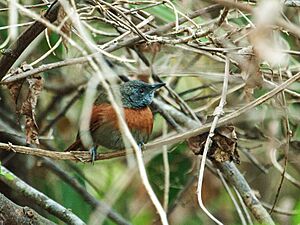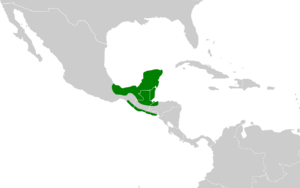Rufous-breasted spinetail facts for kids
Quick facts for kids Rufous-breasted spinetail |
|
|---|---|
 |
|
| Conservation status | |
| Scientific classification | |
| Genus: |
Synallaxis
|
| Species: |
erythrothorax
|
 |
|
The rufous-breasted spinetail is a small bird that belongs to the ovenbird family. You can find this bird in parts of Central America, including Belize, El Salvador, Guatemala, Honduras, and Mexico. Its scientific name is Synallaxis erythrothorax.
Contents
About This Bird
Scientists group animals to understand them better. The rufous-breasted spinetail is a type of bird that has a few slightly different forms, called subspecies. Most experts agree there are two main subspecies:
- S. e. erythrothorax
- S. e. pacifica
This bird is also closely related to the white-whiskered spinetail. They are like "sister species" in the bird world.
What Does It Look Like?
The rufous-breasted spinetail is about 13 to 16 centimeters (5 to 6 inches) long. It weighs between 15 and 19 grams (about half an ounce). Both male and female birds look the same.
- Head and Back: Their face, head, and back are a dark brown color.
- Wings and Tail: Their wings are a reddish-brown, and their tail is also reddish-brown with black lines on the feathers.
- Throat: The upper part of their throat is dark gray with white stripes. The lower part is solid dark gray.
- Chest and Belly: Their chest is a deep reddish-orange. Their belly is a mix of whitish and gray, sometimes with a hint of green.
- Eyes, Beak, and Legs: They have dark red eyes and a black beak. Their legs and feet are bright gray or greenish-gray.
Young birds look similar to adults but have lighter colors on their chest and belly. The S. e. pacifica subspecies is generally paler than the other one.
Where Does It Live?
This bird lives in different areas that are not connected.
- The S. e. erythrothorax subspecies is found in Mexico (in areas like Veracruz and the Yucatán Peninsula), and then south through Belize and Guatemala into northwestern Honduras.
- The S. e. pacifica subspecies lives on the Pacific side, from southwestern Mexico (Chiapas) south through Guatemala into El Salvador.
The rufous-breasted spinetail likes places with lots of thick plants. This includes the edges of lowland forests, areas where forests are growing back, and bushy clearings. It can live from sea level up to about 1,250 meters (4,100 feet) high in Guatemala. In other places, it usually stays below 750 meters (2,460 feet).
Bird Behavior
Movement
The rufous-breasted spinetail stays in the same area all year long. It does not migrate.
Feeding Habits
This bird mainly eats small bugs and spiders. It also enjoys eating small berries. It usually looks for food alone or in pairs. They find their food by picking it off leaves and the ground in thick plants.
Life Cycle and Reproduction
The breeding season for the rufous-breasted spinetail starts around late March and can last until September.
- Nest Building: Both the male and female birds work together to build the nest. It's shaped like a dome and made of thorny sticks. It has a tunnel-like entrance with a small platform. The outside of the nest is covered with bark and stems. Inside, there's a soft cup made of grass and small twigs.
- Eggs and Chicks: Most often, the female lays three eggs, but sometimes she lays four. The eggs hatch after about 17 to 18 days. The young birds are ready to leave the nest about 15 days after they hatch. Both parents help to keep the eggs warm and feed the baby birds.
Bird Sounds
The song of the rufous-breasted spinetail sounds like a "nasal weet!-weet!-weet!-Wur'r'r'r'r'r". They also make other sounds, like a "very high, rising slightly shrieking wrutuwit-wít-truw" and a "nasal, emphatic whit'chew". When they are alarmed, they make a chattering or trilling sound.
Conservation Status
The IUCN (International Union for Conservation of Nature) has listed the rufous-breasted spinetail as a species of "Least Concern." This means it is not currently in danger of disappearing.
- It lives in a large area.
- There are at least 50,000 adult birds, and their numbers seem to be steady.
- No major threats have been found right now.
The future of this bird depends on how much suitable habitat remains. If forests are completely cut down, it can be a problem for them.


